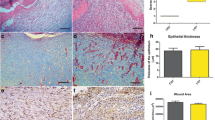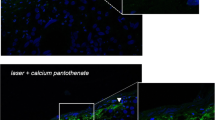Abstract
The aim of this study was to analyze the role of vascular endothelial growth factor (VEGF) in mechanisms of cutaneous remodeling induced by fractional CO2 laser treatment. The dorsal skin of Kunming mice was exposed to a single-pass fractional CO2 laser treatment. Biopsies were taken 1 h, and 1, 3, 7, 14, 28 and 56 days after treatment. Skin samples VEGF expression was evaluated by immunohistochemistry and ELISA, fibroblasts by hematoxylin-eosin staining, and types I and III collagen by ELISA. Staining for VEGF was found in many types of cell including fibroblasts. The amount of VEGF in the skin of laser-treated areas had increased significantly compared to that in the control areas on days 1 and 3 (P < 0.05, P < 0.01, respectively), then decreased by day 7 after treatment and returned to the baseline level. The number of fibroblasts in the skin of the laser-treated areas had increased significantly compared to that in control areas on days 3, 7, 14, 28 and 56 after irradiation (P < 0.05, P < 0.01, P < 0.01, P < 0.01, P < 0.01, respectively). The amount of type I collagen was significantly higher in the skin of the laser-treated areas compared to that in control areas from day 28 to day 56 (P < 0.05, respectively), and type III collagen was significantly higher from day 3 to day 56 (P < 0.05, P < 0.05, P < 0.05, P < 0.05, P < 0.01, respectively). There was a positive correlation between the level of VEGF and fibroblast proliferation early stage after laser treatment (r = 0.853, P < 0.01), but there was no correlation after the first week (r = −0.124, P > 0.05). The amounts of type I and III collagen showed no significant correlations with the expression of VEGF in the late stages after laser treatment (r = 0.417, P > 0.05 and r = 0.340, P > 0.05, respectively). The results suggest that VEGF might be mainly involved in the early stages of wound healing, including the stages of acute inflammation, fibroblast proliferation and vessel formation induced by fractional CO2 laser resurfacing.

Similar content being viewed by others
References
Began AI, Kaufman J (2010) Fractional photothermolysis – an update. Lasers Med Sci 25(1):137–144
Manstein D, Herron GS, Sink RK, Tanner H, Anderson RR (2004) Fractional photothermolysis: a new concept for cutaneous remodeling using microscopic patterns of thermal injury. Lasers Surg Med 34:426–438
Berlin AL, Hussain M, Phelps R, Goldberg DJ (2009) A prospective study of fractional scanned nonsequential carbon dioxide laser resurfacing: a clinical and histopathologic evaluation. Dermatol Surg 35:222–228
Nanni CA, Alster TS (1998) Complications of carbon dioxide laser resurfacing. An evaluation of 500 patients. Dermatol Surg 24:315–320
Grema H, Greve B, Raulin C (2003) Facial rhytides – subsurfacing or resurfacing? A review. Lasers Surg Med 32:405–412
Prignano F, Campolmi P, Bonan P, Ricceri F, Cannarozzo G, Troiano M, Lotti T (2009) Fractional CO2 laser: a novel therapeutic device upon photobiomodulation of tissue remodeling and cytokine pathway of tissue repair. Dermatol Ther 22:S8–S15
Bates DO, Jones RO (2003) The role of vascular endothelial growth factor in wound healing. Int J Low Extrem Wounds 2:107–120
Barrientos S, Stojadinovic O, Golinko MS, Brem H, Tomic-Canic M (2008) Growth factors and cytokines in wound healing. Wound Repair Regen 16(5):585–601
Baum CL, Arpey CJ (2005) Normal cutaneous wound healing: clinical correlation with cellular and molecular events. Dermatol Surg 31(6):674–686
Silveira PC, Silva LA, Freitas TP, Latini A, Pinho RA (2011) Effects of low-power laser irradiation (LPLI) at different wavelengths and doses on oxidative stress and fibrogenesis parameters in an animal model of wound healing. Lasers Med Sci 26(1):125–131
Hakki SS, Bozkurt SB (2011) Effects of different setting of diode laser on the mRNA expression of growth factors and type I collagen of human gingival fibroblasts. Lasers Med Sci. doi:10.1007/s10103-010-0879-5
Nissen NN, Polverini PJ, Koch AE, Volin MV, Gamelli RL, DiPietro LA (1998) Vascular endothelial growth factor mediates angiogenic activity during the proliferative phase of wound healing. Am J Pathol 152(6):1445–1452
van der Veer WM, Niessen FB, Ferreira JA, Zwiers PJ, de Jong EH, Middlekoop E, Molema G (2011) Time course of the angiogenic response during normotrophic and hypertrophic scar formation in humans. Wound Repair Regen 19(3):292–301
Asadi MR, Torkaman G, Hedayati M (2011) Effect of sensory and motor electrical stimulation in vascular endothelial growth factor expression of muscle and skin in full-thickness wound. J Rehabil Res Dev 48(3):195–202
Seitz O, Schürmann C, Hermes N, Müller E, Pfeilschifter J, Frank S, Goren I (2010) Wound healing in mice with high-fat diet- or ob gene-induced diabetes-obesity syndromes: a comparative study. Exp Diabetes Res 2010:476969
Spanholtz TA, Theodorou P, Holzbach T, Wutzler S, Giunta RE, Machens HG (2010) Vascular endothelial growth factor (VEGF165) plus basic fibroblast growth factor (bFGF) producing cells induce a mature and stable vascular network – a future therapy for ischemically challenged tissue. J Surg Res. doi:10.1016/j.jss.2010.03.033
Frank S, Hübner G, Breier G, Longaker MT, Greenhalgh DG, Werner S (1995) Regulation of vascular endothelial growth factor expression in cultured keratinocytes. Implications for normal and impaired wound healing. J Biol Chem 270(21):12607–12613
Möhle R, Green D, Moore MA, Nachman RL, Rafii S (1997) Constitutive production and thrombin-induced release of vascular endothelial growth factor by human megakaryocytes and platelets. Proc Natl Acad Sci U S A 94(2):663–668
Berse B, Brown LF, Van de Water L, Dvorak HF, Senger DR (1992) Vascular permeability factor (vascular endothelial growth factor) gene is expressed differentially in normal tissues, macrophages, and tumors. Mol Biol Cell 3(2):211–220
Jazwa A, Loboda A, Golda S, Cisowski J, Szelag M, Zagorska A, Sroczynska P, Drukala J, Jozkowicz A, Dulak J (2006) Effect of heme and heme oxygenase-1 on vascular endothelial growth factor synthesis and angiogenic potency of human keratinocytes. Free Radic Biol Med 40(7):1250–1263
Wilgus TA (2008) Immune cells in the healing skin wound: influential players at each stage of repair. Pharmacol Res 58(2):112–116
Werner S, Grose R (2003) Regulation of wound healing by growth factors and cytokines. Physiol Rev 83(3):835–870
Ferrara N, Houck K, Jakeman L, Leung DW (1992) Molecular and biological properties of the vascular endothelial growth factor family of proteins. Endocr Rev 13(1):18–32
Dvorak HF, Brown LF, Detmar M, Dvorak AM (1995) Vascular permeability factor/vascular endothelial growth factor, microvascular hyperpermeability, and angiogenesis. Am J Pathol 146(5):1029–1039
Brown LF, Yeo KT, Berse B, Yeo TK, Senger DR, Dvorak HF, van de Water L (1992) Expression of vascular permeability factor (vascular endothelial growth factor) by epidermal keratinocytes during wound healing. J Exp Med 176(5):1375–1379
Khan MH, Sink RK, Manstein D, Eimerl D, Anderson RR (2005) Intradermally focused infrared laser pulses: thermal effects at defined tissue depths. Lasers Surg Med 36(4):270–280
Tan KL, Kurniawati C, Gold MH (2008) Low risk of post-inflammatory hyperpigmentation in skin types 4 and 5 after treatment with fractional CO2 laser device. J Drugs Dematol 7(8):774–777
Clementoni MT, Gilardino P, Muti GF, Beretta D, Schianchi R (2007) Non-sequential fractional ultrapulsed CO2 resurfacing of photoaged facial skin: preliminary clinical report. J Cosmet Laser Ther 9(4):218–225
Chapas AM, Brightman L, Sukal S, Hale E, Daniel D, Bernstein LJ, Geronemus RG (2008) Successful treatment of acneiform scarring with CO2 ablative fractional resurfacing. Lasers Surg Med 40(6):381–386
Orringer JS, Kang S, Johnson TM, Karimipour DJ, Hamilton T, Hammerberg C, Voorhees JJ, Fisher GJ (2004) Connective tissue remodeling induced by carbon dioxide laser resurfacing of photodamaged human skin. Arch Dermatol 140(11):1326–1332
Jiang X, Ge HM, Liu JJ, Ren QS (2011) Fractional scanned carbon dioxide laser induces collagen remodelling in murine dermis. Laser Phys 21:548–553
Ross EV, McKinlay JR, Anderson RR (1999) Why does carbon dioxide resurfacing work? A review. Arch Dermatol 135(4):444–454
Bao P, Kodra A, Tomic-Canic M, Golinko MS, Ehrlich HP, Brem H (2009) The role of vascular endothelial growth factor in wound healing. J Surg Res 153(2):347–358
Brown LF, Van de Water L, Harvey VS, Dvorak HF (1988) Fibrinogen influx and accumulation of cross-linked fibrin in healing wounds and in tumor stroma. Am J Pathol 130(3):455–465
Breuing K, Eriksson E, Liu P, Miller DR (1992) Healing of partial thickness porcine skin wounds in a liquid environment. J Surg Res 52(1):50–58
Hong YK, Lange-Asschenfeldt B, Velasco P, Hirakawa S, Kunstfeld R, Brown LF, Bohlen P, Senger DR, Detmar M (2004) VEGF-A promotes tissue repair-associated lymphatic vessel formation via VEGFR-2 and the alpha1beta1 and alpha2beta1 integrins. FASEB J 18(10):1111–1113
Witzenbichler B, Asahara T, Murohara T, Silver M, Spyridopoulos I, Magner M, Principe N, Kearney M, Hu JS, Isner JM (1998) Vascular endothelial growth factor-C (VEGF-C/VEGF-2) promotes angiogenesis in the setting of tissue ischemia. Am J Pathol 153(2):381–394
Foster RR, Hole R, Anderson K, Satchell SC, Coward RJ, Mathieson PW, Gillatt DA, Saleem MA, Bates DO, Harper SJ (2003) Functional evidence that vascular endothelial growth factor may act as an autocrine factor on human podocytes. Am J Physiol Renal Physiol 284(6):F1263–F1273
Corpechot C, Barbu V, Wendum D, Kinnman N, Rey C, Poupon R, Housset C, Rosmorduc O (2002) Hypoxia-induced VEGF and collagen I expressions are associated with angiogenesis and fibrogenesis in experimental cirrhosis. Hepatology 35(5):1010–1021
Acknowledgments
The authors thank Yuxiu Liu, Institute for Laser Medicine and Bio-photonics, School of Life Sciences & Biotechnology, Shanghai Jiao Tong University, for her technical assistance, and thank Mr. Fitzgibbon for his writing advice. This research was supported by the National Basic Research Program of China (973 Program, 2005CB724302), National High Technology Research and Development Program of China (863 Program, 2008AA0301118), and the Shanghai Commission of Science and Technology (05DZ22318).
Author information
Authors and Affiliations
Corresponding author
Rights and permissions
About this article
Cite this article
Jiang, X., Ge, H., Zhou, C. et al. The role of vascular endothelial growth factor in fractional laser resurfacing with the carbon dioxide laser. Lasers Med Sci 27, 599–606 (2012). https://doi.org/10.1007/s10103-011-0996-9
Received:
Accepted:
Published:
Issue Date:
DOI: https://doi.org/10.1007/s10103-011-0996-9




